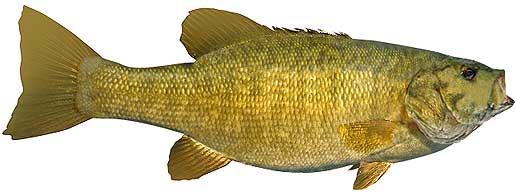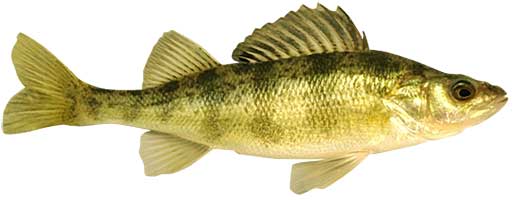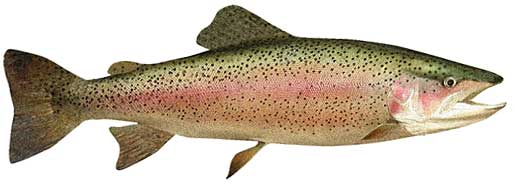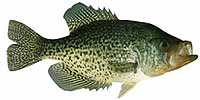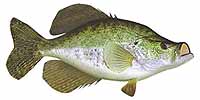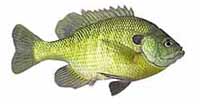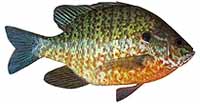Fishing Report For Cascade Reservoir, ID
By Rick Seaman
Last updated on .
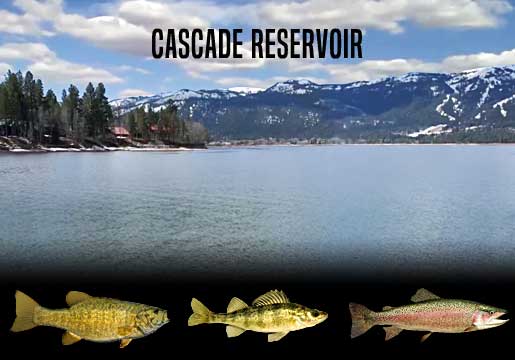
Fishing Reports
Popular Fish Species Cascade Reservoir, ID
Smallmouth Bass
Current Report: Fair
FALL. Fall is here and smallmouth are following schools of baitfish into coves and bays 6 to 20 feet deep. Smallmouth are consistently caught on rocky shorelines and points from around Poison Creek Campground to the Cabarton Day Use Area. They thrive in the cold, clean water, which is an ideal environment for them. Locals report that tube jigs are a great choice when active bass are around 6 to 12 feet deep. Drop shot rigs with small worms or shad shaped plastics are also popular in 10' water or deeper. Jerkbaits, deep-diving crankbaits, and slow-rolled spinnerbaits, are also successful, when bass are shallow to mid depth. Later in Fall, smallies move to slightly deeper water, around 10 to 25 feet deep. Fishing shallow for smallmouth is often good on cold, windy, cloudy and rainy days.
WINTER. Winter will isolate them around deeper structure, points, flats and creek channels, often suspending in open water above these features. They can generally be found from 15 to 40 feet deep. Jigging spoons, tube baits, drop-shot worms, jigs and Ned rigs tend to temp smallmouth in deep water. I like to work these deeper haunts very slowly, as the bass are somewhat sluggish. Here they hold, feeding less frequently, awaiting warmer water to return in Spring.
SPRING. After ice out, when water temperatures rise into the 50's, smallmouth move from deep wintering spots to shallower water, just outside spawning areas. They feed heavily in 3 to 12 feet of water at this time, and are typically caught on jerkbaits, crankbaits, tube baits, Ned rigs, and crayfish imitating plastics. Once water warms into the high 50's, they move into shallower water, and create nests in gravel or sand areas, then lay their eggs. Females then move to deeper water and males remain to guard the eggs, and then the fry. After a couple weeks, the males also move into 8 to 12 feet deep, and feed aggressively. Crankbaits, tube baits, Ned rigs, plastic worms, spoons and swimbaits are catching smallies during this period.
SUMMER. Smallmouth bass are currently feeding shallow early and late in the day in 8 to 12 feet of water. They are being caught on topwater, crankbaits, swimbaits, Ned rigs and tube baits. Smallmouth bass here feed on crawfish, shad, and small sunfish. They prefer rocky or gravel bottom areas, as this is where crayfish live. During the hotter parts of the day, they are being caught on points, humps, and ledges around 20 to 25 feet deep. Often these deeper fish tend to school, so finding them can deliver some fast action. Anglers fishing around the section of the lake nearby near Sugarloaf Island, Roseberry and West Mountain campground, are reporting good catches.
Yellow Perch
Current Report: Good To Very Good
FALL. Early Fall finds yellow perch feeding aggressively in 6 to 18 feet of water, especially around weed lines and drop offs, Later in the Fall, they begin migrating toward Winter holding areas, often in the deeper sections around Sugarloaf Island, Poison Creek, Boulder Creek areas and other many of the bays along the north shore. Minnows, spinners, spoons and crankbaits are ideal this time of year.
WINTER. According to reports by Idaho Fish and Game, ice fishing for perch, as well as other species, is going great. The perch are fat and healthy, and good fishing should carry forward through the coming years. The cold of winter drives perch deeper again in search of food and stable water conditions. Mid-depth flats are ideal Winter holding spots. Early in Winter, perch are caught when they are feeding in weedy areas, in 15 to 18 of water. Later in Winter, as the lake freezes over they descend into 20 to 30 feet of water. Fishing for perch was good again this year, using minnows, mealworms, maggots, and nightcrawlers.
SPRING. Perch spawn in Spring when the water temperature warms to the mid 50's and mid 60's. Anglers begin to catch them in 3 to 12 feet of water using minnows, mealworms, maggots, and nightcrawlers. Docks, weed lines, drop offs, shallow flats, rip rap, and creek mouths along north shore and the bays nearby Donnelly and the Cascade areas, all attract yellow perch searching for a meal. Later in Spring, they drop into 6 to 15 feet of water.
SUMMER. Fat yellow perch here feed primarily on small fish and invertebrates. Spinners, underspins, small crankbaits, mealworms, nightcrawlers and maggots are catching perch in 6 to 18 feet of water. Seek them out in feeding zones 3 to 8 feet deep, around drop-offs and in areas with submerged vegetation.
Rainbow Trout
Current Report: Fair To Good
FALL. Cooling water temperatures in the shallows, draw rainbow trout out of deeper Summer depths. The diet of a rainbow trout consists of insects, small fishes and crustaceans. Anglers are now catching them 8 to 20 feet deep on rocky banks, wind-blown points, rocky structure, humps, and anywhere baitfish are gathering. Now that they had a full summer to grow, there are some nice size rainbow to be caught. Small spinners, spoons, jigs, miniature crankbaits and swimbaits are good choices, as are salmon eggs and prepared baits. Later in Autumn, they move into 15 to 25 feet of water.
WINTER. When Winter sets in jigging spoons, and jigs tipped with bait, are catching nice limits of rainbows out of 20 to 35 feet of water. During Winter, once the ice is safe, ice fishing for rainbows can be very productive, often as shallow as one foot below the ice. Access for ice fishing is available via Van Wyck boat launch, Blue Heron Campground, Boulder Creek launch area and Poison Creek Campground. These baits work well before, during and after ice fishing season. After ice out, deep trolling with leaded line or downriggers, or vertical jigging with spoons and jigs, are the best approach during the cold-water season.
SPRING. As water begins to warm in early Spring, rainbow trout move from their late winter holding areas to shallow, warmer water 6 to 25 feet deep. A good number of rainbows are typically caught from mid morning to late afternoon, during the warmest water of the day. Shallow flats and rocky structure are quick to warm in the afternoon sun. A wide variety of small spinners, spoons and bait are catching most of the fish.
SUMMER. Once Summer is here to stay, the warmer water drives rainbow deeper, 15 to 35 feet deep, occasionally deeper. Trolling with spoons, spinners and crankbaits, using downriggers or leaded line, and drift fishing with bait, are currently the most productive methods. At dawn and dusk, when trout are feeding around shallow weedlines, near Crown Point, Sugarloaf Island and other ledges. Following drop-offs into deeper water, along structure or creek channels, is a major key to getting bites. Anglers fishing from the bank are using nightcrawlers or Berkley PowerBait, with heavy weights on a Carolina rig, to get baits in deeper water.
Fishing Video
Fish species to fish for...
Guide to fishing for largemouth bass, smallmouth bass, channel catfish, black crappie, white crappie, rainbow trout, bluegill, pumpkinseed sunfish, yellow perch, coho salmon, kokanee salmon and tiger muskie at Lake Cascade in Idaho.
 Cascade Reservoir is a 27,000-acre lake with 86 miles of shoreline in the west-central part of the state. Trophy-sized rainbow trout, kokanee salmon, smallmouth bass, and yellow perch all thrive here. At an elevation 4,830 feet above sea level it supports both warm-water and cold-water fish species, with ice fishing opportunities in winter.
Cascade Reservoir is a 27,000-acre lake with 86 miles of shoreline in the west-central part of the state. Trophy-sized rainbow trout, kokanee salmon, smallmouth bass, and yellow perch all thrive here. At an elevation 4,830 feet above sea level it supports both warm-water and cold-water fish species, with ice fishing opportunities in winter.
Primary fish species to catch
Click images for fishing tips and details about each species.
Today's Weather & Forecast
Fishing Boat Rentals
Click here for fishing boat rentals.
Public Boat Launch Ramps & Landings
Click here for boat ramps.
Marinas
Click here for marinas.
Fishing License
Click here for a Idaho Fishing License.
Map - Fishing & Access
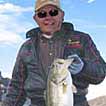 Rick Seaman is a fishing enthusiast with over five decades of fishing experience, a retired tournament fisherman, author of numerous published articles on fishing, and co-author of the book "Bass Fishing - It's not WHAT you throw, It's WHERE you throw it".
Rick Seaman is a fishing enthusiast with over five decades of fishing experience, a retired tournament fisherman, author of numerous published articles on fishing, and co-author of the book "Bass Fishing - It's not WHAT you throw, It's WHERE you throw it".
 Contact Information
Contact Information
Lake Cascade State Park
970 Dam Rd
Cascade, ID 83611
208 382-6544
Fishing lakes in each state
103025
Cascade Reservoir, Idaho Report
IDAHO


Information about fishing lakes in Idaho
Cascade Reservoir offers crappie, bass, catfish, salmon, trout, bluegill and yellow perch fishing in west-central Idaho.


